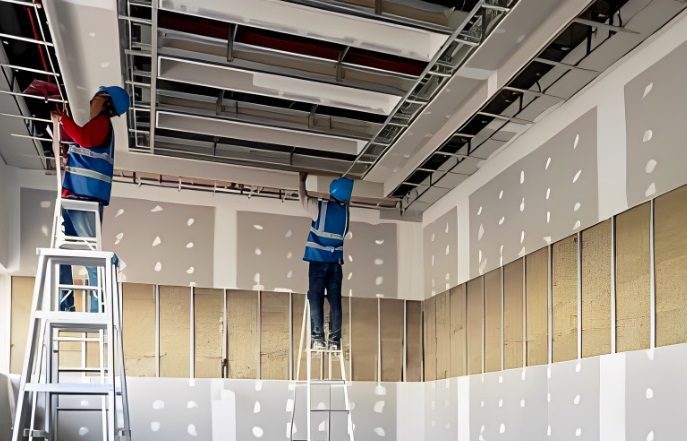Estimating the cost of drywalling a house involves considering various factors. This article explores two distinct approaches for estimating the cost of a drywall project. One method is tailored to larger projects, while the other is suitable for smaller ones.
For sufficiently extensive drywall projects, typically those demanding over 75 sheets of drywall, you can gauge labor costs based on the type and anticipated quantity of materials required. This broad calculation is typically effective for larger projects but doesn’t apply to smaller drywall projects.
For those unaccustomed to construction estimating, devising a budget for a remodel or new construction can be a daunting task. While you may solicit a contractor’s quote for an upcoming project, how can you ascertain whether the price is fair?
The information below aims to empower the average person with an understanding of the costs tied to drywall work. When you grasp the process of creating a cost estimate for a drywall project, you’ll have greater confidence in accepting or rejecting a drywall contractor’s quoted price. We will delve into two job types: large drywall projects and small patches or remodels.
Estimating the Cost of Large Drywall Projects
First, we’ll delve into remodeling or residential construction projects extending beyond a couple of rooms. In this context, a large drywall project entails using more than 75 sheets of drywall. Most drywall contractors base their pricing for such projects on a standard square footage rate.
A contractor’s square footage rate is typically determined by the square footage of drywall required to cover all surfaces. This differs from the square footage of a home’s floor space. For instance, a 2,000-square-foot house with eight-foot-high ceilings may necessitate between 8,000 and 9,000 square feet of drywall, contingent on room layout and the number of interior walls.
Calculating Drywall Square Footage
Drywall square footage denotes the area covered by drywall on both walls and ceilings. For example, a 4-foot by 12-foot drywall sheet covers 48 square feet of surface. Consequently, for each 4-foot x 12-foot sheet of drywall, a contractor should add 48 square feet to their material estimates.
When estimating large residential construction projects, many contractors begin by figuring out the total number of drywall sheets required for the entire project. They may inspect each room and tally the sheets needed, either by physically visiting each room or virtually measuring a project using blueprints.
Contractors employ various methods to estimate the total sheet count, but for the average person, the most accurate approach is to measure all walls and ceilings and calculate the total square footage to be covered with drywall.
Imagine a room that’s 12 feet wide, 16 feet long, and 9 feet tall. The two 12-foot long walls would require 108 sq ft of drywall, and the 16-foot long walls would need 144 sq ft of drywall. Additionally, the ceiling would necessitate 192 sq ft of drywall. In total, this room would require an estimated 444 sq ft of drywall.
Consideration for Windows and Door Openings
When measuring surfaces to determine drywall needs, it’s advisable to include areas for windows and doors in the total sheet count. Even though these openings won’t be covered with drywall, you’ll still need to purchase a similar amount of drywall. Furthermore, some additional labor is needed for these areas, so it’s prudent to include them in your estimate, unless they occupy a significant portion of the surface.
Example of Estimating Drywall for a Single Room
Imagine a 15′ by 15′ room with 8-foot ceilings:
- Wall A: 15′ x 8′ = 120 sq ft
- Wall B: 15′ x 8′ = 120 sq ft
- Wall C: 15′ x 8′ = 120 sq ft
- Wall D: 15′ x 8′ = 120 sq ft
- Ceiling: 15′ x 15′ = 225 sq ft
Total Square Footage: 705 sq ft



Significance of Estimating Scrap Material
It’s inevitable that you’ll have leftover scrap drywall when you complete a project. Properly disposing of these scraps in a landfill or at a local transfer station is crucial. Knowing the quantity of scrap material helps you decide whether to order a dumpster or use your truck to haul it away.
Multiplying the drywall square footage by the prevailing rate
Once you’ve determined the total sheet count, and consequently, the total square footage of required drywall, you can multiply this by a contractor’s square footage rate. The total drywall square footage numbers can be used to estimate both material and labor costs.
For instance, if you find that your house will require 150 sheets of 4-foot x 12-foot drywall, you’ll need about 7,200 sq ft of drywall (48 sq ft * 150 sheets = 7,200 sq ft). If a contractor charges $1.30 per square foot for labor and material, your project is estimated to cost around $9,360.
Material Costs
Material costs alone typically range from 45 to 60 cents per square foot. Contractors may benefit from negotiated discounts at local drywall supply stores or opt for The Home Depot® or Lowes® for competitive prices.
Material costs of 45 to 60 cents per square foot should encompass not only the drywall itself but also fasteners, glue, and miscellaneous supplies. This may or may not include the cost of finishing materials.
Labor Costs
The variation in pricing from one company to another is usually more pronounced in labor costs than material costs. Labor costs vary due to differences in company structure, overhead, and the skill level of employees. Labor prices also fluctuate significantly from state to state and city to city.
Labor prices for hanging and taping drywall can span from 60 cents per square foot to 120 cents per square foot. Prices vary based on the job’s complexity, such as high ceilings, numerous angles, decorative soffits, and architectural features.
Don’t expect the same square footage rates for small, one-room jobs or minor remodels. Most contractors won’t quote based on standard footage rates for projects under 75 sheets. For instance, a 15′ x 15′ room requiring only 16 or 17 sheets of drywall wouldn’t receive a square footage quote unless it’s part of a larger project with multiple rooms of a similar size.
Estimating Small Drywall Jobs
Small drywall jobs can encompass one-room residential renovations, simple patches or repairs, or kitchen and bathroom remodels. Contractors typically break down their internal cost calculations into labor and materials, similar to larger drywall projects.
As with large projects, the first step is to determine the amount of material needed for the job and use this to estimate material costs. The method is very similar to what is described for large projects.
However, the square footage of material can’t be used to calculate labor costs when only a small number of total sheets are needed. For small jobs, a contractor will usually estimate how many days (or man-hours) it will take to finish the project. This estimate is based on the contractor’s experience and knowledge.
For example, if a job requires only 17 sheets of 4-foot x 12-foot drywall, totaling about 816 sq ft, even at $1.30 per square foot, it would take at least three days of labor to complete. Material costs may be around $425 – $500, leaving approximately $500 for labor. A skilled worker may not find this rate sufficient. Depending on project specifics, the cost for a one-room project might exceed $1,200 to $1,400.
Keep in mind that journeymen typically expect to earn between $200 and $300 per day, while less experienced helpers usually seek around 15 to 20 dollars per hour. As a result, small remodel jobs often come with a higher square footage rate compared to an entire house.
Get Multiple Quotes
In all cases, it’s advisable to conduct research on various companies and obtain multiple quotes. If you’re unfamiliar with local pricing, obtaining at least three quotes can provide a clear picture of fairness. Choosing a reliable and skilled company is more vital than solely seeking the lowest cost.
Consulting with different companies allows you to discover various aspects of your project that you may not have considered previously. One company might recommend something that another hasn’t included. Interacting with multiple companies offers insights into their business practices and helps assess their reliability. The best contractor might not always be the cheapest but their experience can help you avoid unnecessary issues and save money in the long run.
Use your judgment when selecting a contractor, as it can significantly impact the quality of the final product. Reviewing references from friends and others can be a valuable way to learn about a company’s reputation.
A company’s reputation becomes most apparent after they complete a project. Their ability to address challenges encountered during the project is telling. It’s challenging to predict exactly how a company will perform without previous experience. Therefore, speaking to others who have worked with the company you’re investigating can provide insight into the entire experience, including the quality of the final product.
Wrapping Up
In summary, you can anticipate paying between 105 and 180 cents per square foot of drywall used for material and labor costs. Additional costs may apply for projects with high ceilings or complex architectural features. For small projects involving fewer than 75 sheets, expect labor costs of $200 to $300 per journeyman worker per day, in addition to material expenses.
It’s important to note that the information above serves as general guidelines for understanding common methods of estimating drywall costs. Individual contractors may have different approaches to estimating costs than those presented here, so it does not guarantee a specific contractor’s price.



tag: # Cost of Drywalling a House







